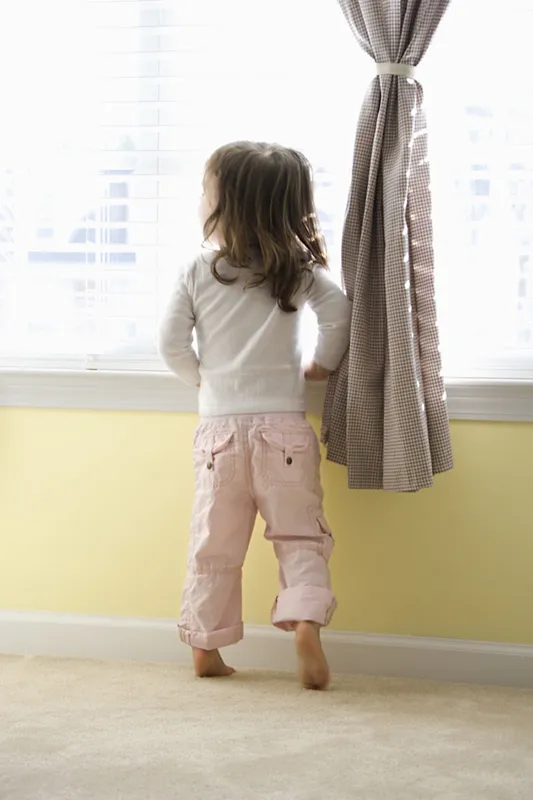Toe Walking in Children – Causes, Risks and Treatments

- What Is Toe Walking?
- Causes of Toe Walking in Kids
- Symptoms of Toe Walking in Children
- Risks and Complications of Toe Walking in a Child
- Diagnosis of Child Toe Walking
- What Is Idiopathic Toe Walking?
- Treating Toe Walking in a Child
- Exercises to Help Children Who Walk on Tiptoes
- How to Prevent Your Child From Walking on Tiptoes
- Questions to Ask Your Child’s Doctor About Toe Walking
- When Should You Call the Doctor?
- FAQs
Toe walking in children is common, particularly when they first begin to walk. Many children go through this phase as they experiment with their newfound mobility and, most naturally, outgrow it as they develop better coordination and balance. By the age of three, toe walking usually disappears completely. However, if your child continues to walk on his toes frequently or beyond this age, it could signal underlying issues such as muscle tightness (like in the Achilles tendon), neurological conditions, or developmental delays. In some cases, children with conditions like cerebral palsy or autism may exhibit persistent toe walking. If toe walking continues or seems constant, it’s important to consult a physician to assess the situation, identify the cause, and explore appropriate interventions or therapies. Early detection and treatment can help address any potential concerns effectively.
What Is Toe Walking?
Toe walking is the practice of walking on the tip of the toes. Kids walking on tiptoes tend to not touch the ground with their heel as they take their step. This is a habit that kids learn as they begin to cruise around holding onto furniture and is deemed normal in children up to the age of 2 or 3. However, if it goes on beyond this age, it may mean that your child has made a habit of it or has other underlying issues.
Causes of Toe Walking in Kids
Toe walking in kids is usually no reason for worry as it subsides after two or three years. However, if it does not, it can be associated with some underlying causes and conditions. Some of the causes of toe walking in kids are discussed below:
1. Short Achilles Tendon
Children who have a short Achilles tendon will have difficulty in stretching it completely. This may encourage them to walk on their toes and even prevent them from standing flat on their feet.
2. Cerebral Palsy
Several types of cerebral palsy are linked to difficulty in standing and walking. Spastic cerebral palsy is known to make the muscles around the feet very stiff, which can cause difficulties while walking. Some premature babies may also suffer from a brain haemorrhage that can cause cerebral palsy and lead to problems with walking, encouraging toe walking.
3. Periventricular Leukomalacia
Premature babies, in some cases, may suffer from nerve damage which can lead to difficulty in walking. This may lead to toe walking and other walking issues
4. Spastic Hemiplegia
Sometimes, due to cerebral palsy, the Achilles tendon in the kids can be pulled up very tight making it hard for them to place their feet flat on the ground. This can encourage toe walking.
5. Autism and Language Delays
Autistic children and children with developmental delays can have prolonged toe walking paired with speech and social delays.
6. Idiopathic Toe Walking
If your child has no underlying condition leading to toe walking and has normal movement in the ankle joint, but continues to walk on his toes, it can be idiopathic toe walking. This essentially means that there is no specific reason for it and his toe walking may have developed by habit.
Symptoms of Toe Walking in Children
While toe walking is common in toddlers learning to walk, it can sometimes persist and signal underlying issues. Recognizing the symptoms early can help determine if further evaluation is needed.
- Toddler walking on toes or balls of feet: The most obvious symptom is when the child consistently walks on the toes or the balls of their feet instead of using a normal heel-to-toe gait.
- Difficulty with balance: Children who walk on their toes may experience issues with balance, making it harder for them to stand still or walk without stumbling.
- Tight calf muscles: Persistent toe walking can lead to tight calf muscles or shortened Achilles tendons, which may cause discomfort or difficulty when attempting to walk flat-footed.
- Delayed motor development: Toe walking can sometimes be associated with delayed gross motor skills, such as running, jumping, or climbing stairs.
- Foot or leg pain: Some children may experience foot or leg pain due to the unusual pressure placed on certain parts of the feet when toe walking.
Risks and Complications of Toe Walking in a Child
While toe walking is common in many kids up to the age of three, the risk of developing idiopathic toe walking may be higher in families with a history of kids who had the problem.
Constant toe walking may cause damage to the joints and the muscles of the kids and even increase his risk of falling and stumbling. He may also be subject to ridicule by his peers as he grows, which can affect his confidence.

Diagnosis of Child Toe Walking
The diagnosis for toe walking is through a physical exam as it is easily observed. However, the doctor may also perform a gait analysis or EMG (electromyography) in some cases. A thin needle is inserted into the affected muscles or the nerve along with an electrode to measure the electrical activity during an EMG. If toe walking is a result of developmental delays, autism or cerebral palsy, the doctor may recommend a neurological exam or a developmental evaluation to identify the cause.
What Is Idiopathic Toe Walking?
If your child walks on his toes even after he is three but is not diagnosed with any condition that may have caused it, he may have idiopathic toe walking. Children with idiopathic toe walking may walk on their toes constantly and keep their knees straight and locked as they walk. You may even notice that they walk on the tiptoes of both their feet and also stand flat on both feet sometimes. Idiopathic toe walking in children can sometimes also be attributed to a history of toe-walking with other children in the family.
Treating Toe Walking in a Child
If toe walking persists in your child beyond the age of three and you are concerned, you may want to get a diagnosis that can identify the cause of toe walking in your child. The right course of therapy and treatment for correcting toe walking can prevent the chance of damage to the joints and muscles. The doctor, based on the cause of the toe walking, may suggest the following treatment options for your child.
1. Physical Therapy
Stretching exercises and physical therapy can be used to treat children with a short Achilles tendon.
2. Ankle-foot Orthosis
Therapists may also ask your child to wear an ankle-foot orthosis. This plastic brace holds the foot at a 90-degree angle and extends up to the back of the leg. This brace can be worn all day and night and taken out during exercises or bathing.
3. Serial Casting
An orthopaedist will apply a plaster or fibreglass cast to enable the tendons to stretch and provide your child with a better range of ankle movement. The cast will be changed every other week as the tendon stretches and will be taken out when the tendon is long enough. This cast cannot be removed when required.
4. Surgery
If your child does not respond to other treatments, the doctor may recommend surgery to stretch the tendon.
5. Neurological and Development Evaluation for Autism and Cerebral Palsy
If your child’s toe walking stems out of underlying conditions like cerebral palsy or autism, your doctor will perform a developmental evaluation.
Exercises to Help Children Who Walk on Tiptoes
Stretches and exercises can help your child overcome the habit of toe walking, especially in the case of idiopathic toe walking. Stretches help loosen stiff muscles in the calf and improve the range of movements in the ankles. Children with a short Achilles tendon also benefit from regular exercises and stretches.
- Calf stretch: Your child needs to lay on his back with his knees straight. While he is in this position, bend his foot up so that it points towards his knees. Stretch the foot as much as your child can tolerate. Repeat this ten times on both feet.
- Achilles tendon stretch: Ask your child to lay on his back on a firm surface. You will need to bend his knee and carefully point his toe towards the knee and hold the position for 15 seconds or until your child can tolerate it. Repeat this ten times.
- Sit to stand: Seat your child on a small chair so that his feet touch the ground. With both your hands, hold his legs right below the knees and push it flat against the floor. As you do this, encourage your child to stand. You can engage your child in various activities like singing as you perform this exercise.
How to Prevent Your Child From Walking on Tiptoes
- Stretches: Toddlers don’t have flexible muscles. Stretches can help loosen stiff muscles and provide them with a better range of movement in their ankles.
- Ankle weights: These can help lengthen your child’s tendon and help him walk with his feet flat on the ground. Always use the right-sized weights and consult a therapist before doing so.
- Shoes: The right shoes with proper ankle support can prevent toe walking. You can encourage your child to wear shoes in the house often to help him walk on his feet.
- Tactile training: Provide your child with an opportunity to walk barefoot on different surfaces like grass, sand, a tray of rice, etc. This will give him an idea of what it feels like to walk with his whole feet pressed against the ground.
Questions to Ask Your Child’s Doctor About Toe Walking
If your kid is walking on toes beyond the toddler years, it’s important to consult with a doctor to address any potential concerns. Here are some key questions to ask your child’s doctor about toe walking:
- Is persistent toe walking a sign of an underlying medical condition, such as tight muscles or a neurological issue?
- What tests or evaluations will be needed to determine the cause of toe walking in my child?
- Are there any non-invasive treatments, such as physical therapy, that can help correct this walking pattern?
- At what point should we consider more advanced treatments, like braces or surgery, if toe walking continues?
- How can we encourage normal walking habits at home, and are there exercises we can do to help?
When Should You Call the Doctor?
If you notice toe walking in your child, it may be wise to consult a doctor to get a proper diagnosis. You may also need to call your doctor if you notice that your child
- Constantly walks on his toes
- Has stiff muscles
- Lacks coordination
- Stumbles very often
- Has delayed motor skills
- Has trouble bearing weight on his feet
- Begins to lose the motor skills that he had
FAQs
1. Can toe walking in children be related to sensory processing issues?
Yes, in some cases, children with sensory processing disorders may engage in toe walking as a way to manage sensory input. The sensation of walking on their toes can provide them with a form of self-regulation or comfort, particularly if they are hypersensitive to certain textures or sensations on their feet.
2. Does persistent toe walking in children affect posture in the long term?
Yes, prolonged toe walking can potentially lead to poor posture or musculoskeletal imbalances. Over time, it may cause tightness in the calf muscles, affect the alignment of the legs and hips, and contribute to back or joint pain if left untreated.
3. Can toe walking in children affect their ability to wear certain types of footwear?
Yes, children who consistently toe walk may find it uncomfortable or challenging to wear certain types of footwear, especially shoes with flat soles. This can affect their overall comfort and may require specialized shoes that provide additional support.
This was all about a child walking on tip toes. Tiptoeing in children is very common and, in most cases, is no reason for worry. However, if you notice that it continues even after your child grows, you may want to consult a healthcare professional to rule out any serious issues.
References/Resources:
1. Toe Walking; Cleveland Clinic; https://my.clevelandclinic.org/health/diseases/21017-toe-walking
2. Toe walking in children; Mayo Clinic; https://www.mayoclinic.org/diseases-conditions/toe-walking/symptoms-causes/syc-20378410
3. Toe Walking; Nemours Kids Health; https://kidshealth.org/en/parents/toe-walking.html
4. Femoral Anteversion; Boston Children’s Hospital; https://www.childrenshospital.org/conditions/femoral-anteversion#symptoms-and-causes
5. Pigeon Toes (Intoeing); American Academy of Pediatrics; https://www.healthychildren.org/English/health-issues/conditions/orthopedic/Pages/Pigeon-Toes-Intoeing.aspx
6. In-Toeing; Nemours Kids Health; https://kidshealth.org/en/parents/gait.html
7. Toe Walking; Johns Hopkins Medicine; https://www.hopkinsmedicine.org/health/conditions-and-diseases/toe-walking
Also Read:
Foot Pain in Children
Growing Pain (Leg Pain) in Kids
In-Toeing and Out-Toeing in Children
Can Your Child Hop on One Leg Yet?
Ways to Help and Prevent Child Walking on Tiptoes
Was This Article Helpful?
Parenting is a huge responsibility, for you as a caregiver, but also for us as a parenting content platform. We understand that and take our responsibility of creating credible content seriously. FirstCry Parenting articles are written and published only after extensive research using factually sound references to deliver quality content that is accurate, validated by experts, and completely reliable. To understand how we go about creating content that is credible, read our editorial policy here.
























